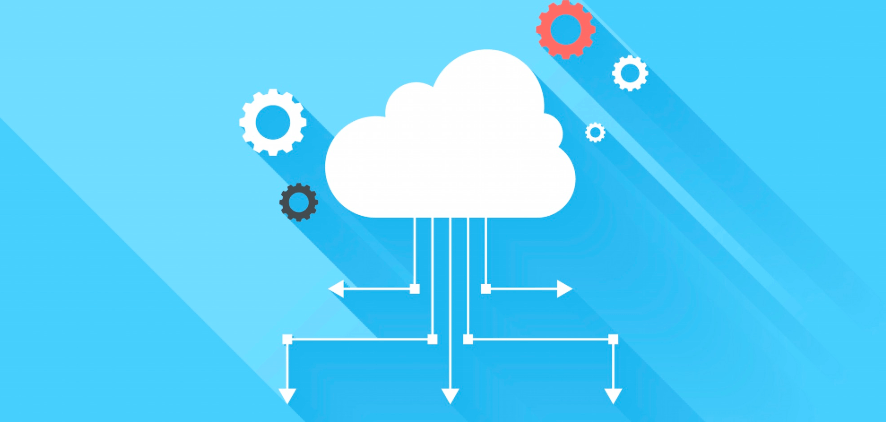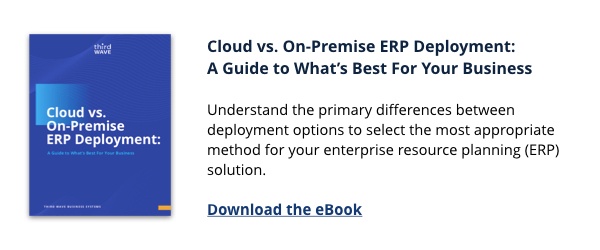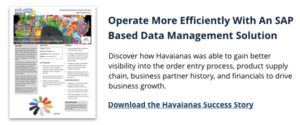We’ve explored how to running SAP Business One in the Cloud, the difference between Private vs Public Cloud solutions, and how to improve business agility with the cloud. Let’s now discuss the benefits of running SAP Business One Cloud.
Key Benefits of SAP Business One Cloud
- Increased Usability: You have the ability to store your data over a network and then access it through a web-based browser or mobile app, so you can access your ERP system from anywhere in the world at any time you choosing.
- Manageability: Since your systems are stored on servers at a remote location, your systems are managed by a Cloud provider.
- Cost: Besides drastically reducing the operations and maintenance costs of infrastructure, the costs are also predictable for your organization in terms of monthly fees.
- Security: Being hosted at a hardened facility, your corporate data is safe at the Cloud hosting center being handled by security experts.
- Scalability/Elasticity: Easily scale up or down depending on your current usage requirements. Accommodate your organizational needs and changing market conditions with the Cloud ERP.
- Automation: Your Cloud providers are responsible for server maintenance and take care of any system updates so the process is transparent for you.
- Environmentally Friendly: By reducing your energy consumption, the Cloud offers a more environmentally friendly method of meeting your business requirements.
There’s no doubt that the benefits of the Cloud improve your business’ productivity, but with all of the pros, there are some cons to consider. How will these potential negatives impact your business? Keep in mind that Cloud is relatively new and there are always associated kinks to work out as the technology improves.
Learn more: Cloud ERP Deployment vs. On-Premise Deployment Options: Pros and Cons
The Cloud can give your company an excellent opportunity to take your business to the next level and reinvent yourself. Embrace the change. You have the option to add value to your business, so why not take it? If you were to take the benefits of your traditional solution vs. the Cloud, you would most likely see that the benefits of the Cloud can outweigh those of the traditional methods.
Third Wave Business Systems uses a cloud deployment methodology that allows you to maximize the advantages and minimize the disadvantages of cloud computing.
Contact Third Wave to get more educated on the benefits of SAP Business Once Cloud and start making smarter business decisions today!

Benefits of Running SAP Business One Cloud
Learn More
A number of misconceptions exist around different ERP deployment models that distract an organization from properly choosing the ERP solution that is best suited for their needs. These common misconceptions can lead to overspending, loss of data accessibility, limited functionality, surprise costs, and decreased business agility.
To help you improve your ERP selection process, we are clarifying the top four common misconceptions to consider when choosing an ERP deployment model:
Misconception 1:
“Upgrades are seamless at no additional cost with a public cloud (SaaS) ERP.”
Reality:
An organization still has to do testing and train on new functionality before moving to an upgraded version within the public cloud. Often times, customers will require consulting services to help them test and implement new functionality. Many SaaS cloud ERP vendors fail to mention this fact, and instead, focus on the elimination of time needed to physically upgrade software which removes a very minimal amount of the cost.
Some ERP vendors charge up to 30% of the annual SaaS fee to provide a sandbox testing environment which allows you to test your specific implementation, customizations, and integrations. The steps, effort, and cost of upgrading on-premise, private cloud, or SaaS (multi-tenant cloud) deployments are all the same. The cloud simply means your ERP solution is running on someone else’s hardware; it’s still software!
Misconception 2:
“All ERP software is basically the same; I just need to know that I can run it in the cloud.”
Reality:
Each ERP solution has its own set of benefits and features, some being more appropriate for certain industries over others. The biggest strengths of SAP Business One are the depth of functionality, flexibility, adaptability and it can be deployed on-premise or in the cloud.
Learn more: Cloud ERP Deployment VS. On-Premise Deployment Options: Pros And Cons
Misconception 3:
“When my ERP is deployed in the cloud, our company owns the data, and we can easily download all of it anytime, at no additional cost.”
Reality:
Some cloud ERP vendors are notorious for holding a company’s data hostage. They make it very difficult and expensive to extract your data which makes it painful to leave their ERP solution while subjecting you to excessive price increases. With Third Wave Business Systems and SAP Business One, you will own your data and have unlimited access to your data whether the solution is deployed on-premise or in the cloud.
Misconception 4:
“On-premise deployment always means higher costs.”
Reality:
This is a complex topic, with many factors affecting whether or not an on-premise deployment has higher costs versus a cloud deployment. Focusing on the 10 Year Total Cost of Ownership provides a clearer evaluation of costs associated with each of the ERP solutions being evaluated. SaaS Cloud ERP solutions generally have a significantly higher 10 Year TCO than the other deployment options.
In conclusion, choosing your ERP deployment model also requires careful consideration into which ERP system you choose to implement and whom you choose to deploy your solution with.
Get Expert Help Choosing Your ERP Deployment Model
SAP is the world leader in ERP software and SAP Business One is a highly recommended solution for both on-premise and cloud ERP deployment. By working with an experienced SAP Business One Partner, like Third Wave Business Systems, organizations gain unbiased recommendations on ERP deployment models that match their business needs. Companies also gain the option to securely migrate between cloud and on-premise deployments options because what works for a growing business currently may not work in the future.
Third Wave Business Systems is an SAP Gold Partner, as well as North America’s longest-standing SAP Business One partner. Businesses trust our experts to implement ERP solutions for both on-premise and cloud deployment models by providing in-depth industry expertise every step of the way.
To learn more about choosing the right ERP deployment method for your business, schedule a customized demo with a Third Wave expert today.

4 Common Misconceptions Around Choosing an ERP Deployment Model
Learn More
When purchasing an enterprise resource planning (ERP) solution, decision-makers must understand how each ERP pricing option can affect their business for both the short and long-term. Understanding the differences in each pricing structure can prevent businesses from overspending as well as increase the ERP system’s return on investment (ROI).
There are two ways to purchase an ERP solution. The first ERP pricing option is a one-time license fee with an annual maintenance fee. This option provides a perpetual use license for the software that allows you to use it as long as you like.
The second ERP pricing option is a subscription or Software-as-a-Service (SaaS) fee that allows you to use the ERP solution as long as you pay the subscription fee.
SAP Business One ERP Pricing Options
Unlike many ERP solutions, SAP Business One can be purchased using either pricing model, For example, a company may choose to implement SAP Business One with the SaaS option deployed in a multi-tenant cloud, or may prefer a private cloud or on-premise server deployment with a one-time licensing fee option.
Our ERP Pricing Option Recommendation
At Third Wave, we believe that the license/maintenance fee option is the best ERP pricing option for all organizations for several reasons:
- You gain the flexibility to deploy the ERP software either on-premise, in the private cloud, or a multi-tenant cloud, with the freedom to migrate SAP Business One between deployment options.
- Your business owns the software versus subscribing/renting. Even if the maintenance fees are not paid, the company will still be able to use the ERP system and access their data.
- After about three years, the license/maintenance fee option becomes increasingly less expensive than the SaaS fees. This is due to the fact that the annualized cost of the one-time license fees and annual maintenance fees drops significantly over time, while the subscription fees for the SaaS model stay consistent or increase year-to-year.
- The license/maintenance fee model also makes it easier to work with the ERP partner best aligned to your company’s needs.
About Third Wave Business Systems
Third Wave Business Systems is an SAP Gold Partner, the world leader in ERP software. As North America’s longest-standing SAP Business One partner, businesses trust our experts to implement ERP solutions for both on-premise and cloud ERP deployment models providing in-depth industry expertise every step of the way. Our experts work with you to understand your business needs and goals and to choose the best ERP pricing option for your business.
To learn more about ERP pricing options with SAP Business One, schedule a customized SAP Business One demo with a Third Wave expert today.

Which ERP Pricing Option is Right For Your Business?
Learn More
An enterprise resource planning (ERP) solution integrates strategic business processes into a single, comprehensive information system, increasing the efficiency and agility of the enterprise. Choosing between a cloud ERP or on-premise deployment model should not be a key decision factor, however.
An organization must first evaluate ERP solution capabilities to determine if it meets current and future needs. The deployment option should be the next decision.
Where a solution is deployed does not define the ERP capabilities of the solution. If the primary consideration is where to deploy the ERP solution, you will very likely end up with the wrong ERP solution.
Cloud vs. on-premise deployment is a rent vs. buy decision for the technical infrastructure. A cloud ERP deployment is the renter’s option: an outside partner or vendor provides the hosting environment in exchange for a monthly fee. An ERP solution and the data can live in a private or multi-tenant cloud, with pros and cons for each option. It is possible that a licensed ERP solution can also live in the cloud, so you also have the option of owning the software while renting the infrastructure it lives within.
With an on-premise deployment, the company owns and maintains the infrastructure needed to run the ERP solution locally. The ERP vendor’s business model will dictate if the vendor or a partner do the implementation.
Related reading: Business Benefits of Implementing an ERP Solution
Three Primary Factors for Considering Cloud ERP vs. On-Premise Deployment:
1. Total Cost of Ownership
Much of the conversation around cloud vs. on-premise deployment centers around the different cost structures of the two options, in addition to the ERP purchase model decision (SaaS, subscription model vs. licensed). A cloud ERP deployment usually provides a consistent cost outlay because the cloud infrastructure can scale incrementally without huge capital expenditures.
A cloud ERP system environment can be provisioned in days vs. weeks that it may take for on-premise environments. Cloud deployment will not eliminate the majority of your internal network because you still need to manage internet connectivity, email, printer management, etc.
However, it is essential for an organization to evaluate an ERP solution as a long-term investment. For example, when considering Third Wave’s option of SAP Business One and a private Amazon cloud deployment, this configuration will have the same initial total cost of ownership (TCO) as Netsuite’s SaaS Multi-tenant cloud ERP solution. When you expand the TCO comparison to 10 years, SAP Business One is 50% of the cost of Netsuite.
2. ERP Solution and Data Ownership
Both on-premise and private cloud deployment installed with licensed ERP software mean that you own your ERP solution and your data no matter what happens. You will retain complete access to all information and the software at all times, even if you stop paying annual maintenance fees.
If you deploy to a multi-tenant cloud with software-as-a-service delivery through a vendor like NetSuite, you risk losing the ability to run your company or access critical data if you withhold payment.
Be aware that some vendors are known to surprise customers with excessive price increases that you are forced to absorb because you cannot change to a new solution overnight. If you migrate to a new solution, you may be surprised with the difficulty and cost involved in exporting your data from a SaaS solution. The longer they hold your data hostage, the longer you need to pay them.
3. Become the “Master Of Your Domain”
By selecting an on-premise or private cloud ERP deployment, companies maintain a significantly higher level of control over their system, allowing them to become the “master of their domain.” This control results in significant business benefits and cost savings:
- You decide when to conduct software upgrades so that it’s convenient for your business.
- Avoid constraints around transaction volumes and integration point bandwidth.
- You own the environment, which eliminates resource constraints and contention – your system will not slow down once the whole country is at work.
- Avoid hidden costs that some vendors charge associated with usage spikes and increased data volumes.
To Conclude
The ERP deployment chosen by an organization is an important decision, but it’s something that your organization should consider after selecting the right ERP solution based on its functionalities and benefits. An experienced ERP partner like Third Wave Business Systems can help a company like yours make unbiased, informed decisions on the best deployment option. We can also help you migrate between cloud and on-premise deployments because what works for a growing business one day may not work in the future.
For most businesses, Third Wave strongly recommends deploying over the private cloud because it gives organizations the freedom to easily scale at their own pace without the drawbacks and restraints of the multi-tenant cloud.
Third Wave is a Gold Partner of SAP, the world leader in ERP software. As North America’s longest-standing SAP Business One partner, small to enterprise level businesses trust us to implement scalable on-premise and cloud ERP solutions with hands-on expertise every step of the way.
To learn more about how we enable companies to implement scalable ERP solutions, schedule a customized demo with a Third Wave expert today.

Cloud ERP Deployment vs. On-Premise Deployment Options: Pros and Cons
Learn More
Choosing and implementing a cloud ERP solution is an investment for SMBs, so it’s critical for companies to take an organized approach when evaluating their options before making a decision. Because of this, it is important to note that you should not select your ERP solution on any single aspect of a system’s features, particularly the method of deployment.
Each ERP solution offers different features, representing pros and cons that are relevant depending on an organization’s needs. Cloud ERP selection must take into account all the various features and factors and how well they meet business requirements, and not be based solely on whether the ERP is offered as a cloud or on-premise solution.
Selecting A Cloud ERP Solution
1. Create an ERP functionality requirements list
Before deciding on a cloud ERP solution, it is important to explore ERP options by creating an ERP requirements list. Clearly delineating the business needs for the system, currently and in the future, as well as stakeholder expectations is one way to ensure that ERP implementation and adoption has the best chance for success.
This list should begin with the features that you will require of an ERP solution. Relevant questions include:
- What are some functionality gaps in current business processes?
- What business challenges can an ERP solve?
- Which features will be used immediately?
- Which features can be added in the future?
- Is customization available?
- Is the solution scalable and flexible enough to meet future needs?
- Do I have deployment options to pick from, now and in the future?
Because an ERP system can encompass many different departments and processes throughout the company, it is essential to understand the needs of all potential users of the system. Surveying stakeholders throughout the company not only helps a decision-maker to ensure that the ERP solution meets all needs, but it also promotes user engagement once you implement the new system.
2. Create implementation requirements list
It’s important to understand whether a cloud or on-premises deployment will best suit the organization.
Understanding the system requirements of on-premise versus cloud ERP solutions can help an organization to make the decision that best meets their needs. This will also help to determine the total cost of ownership of the system while avoiding potential hidden costs and responsibilities down the line.
Learn more: How Third Wave Helps You Understand the Costs Upfront When Investing in ERP Software
3. Define measures of success
Once your organization has a deep understanding of how it will use and benefit from the ERP solution, you can define the ERP success metrics. Measures of success could include streamlined processes, shorter business cycles, customer satisfaction, reduced costs, adoption rates, and more. Knowing how stakeholders will measure success, and setting procedures in place to gather the necessary data is vital to proving the success of the operation as a whole.
After feature requirements have been clearly defined, the network has been assessed, and success has been planned, an organization can move on to the next steps in selecting an ERP system.
A selection team of key stakeholders should be gathered, a vendor shortlist created, and an RFP should be constructed and distributed to potential vendors. When the RFPs are returned, the selection team should review all proposals based on critical factors in a standardized manner.
Not only does this allow an organization to meet the needs of employees throughout the organization, but it also helps to drive engagement by involving different departments throughout the process.
To learn more about how Third Wave enables companies to implement scalable ERP solutions and drive transparency and growth throughout an organization, schedule a customized demo with a Third Wave expert today.

3 Steps for Selecting Your Cloud ERP Solution
Learn More
An Enterprise Resource Planning (ERP) solution automates and integrates functional business processes into a single system. Organizations with applications spanning multiple departments and supply chains will find ERP solutions especially useful to streamline operations, such as inventory management. Information can be automatically and accurately adjusted as a result of the various processes and transactions the ERP automates, saving time and money while eliminating human error.
Integrating all of an organization’s processes into a single system seems like an overwhelming task; however, the benefits of an ERP solution can be profound.
Top 5 Business Benefits of an ERP solution:
1. Cost Savings
Rather than paying for several different departmental applications and subscriptions, an ERP solution uses a single platform. Getting applications to communicate with one another often requires an application program interface (API), which can be costly to create and maintain.
A single source of accurate, real-time information provides a rich source of data that businesses can apply throughout the organization. Cost savings are multi-faceted, but for most businesses, creating one efficient process that takes a transaction from start to finish is where they save the most. Items don’t have to be keyed into the system multiple times, and the single source of data provides a place to work from for purchase planning, as well as connect outside integrations for key stakeholders.
Learn more: How Third Wave Helps You Understand the Costs Upfront When Investing in ERP Software
2. Efficiency
An ERP solution reduces repetitive processes, including manual data entry, and can be applied to automating certain operations as well, including core operations like as order-to-cash and purchase-to-pay. Freeing employees from repetitive, manual processes allows those resources to be directed toward higher-level, strategic objectives while improving the efficiency and accuracy of the processes themselves.
With an ERP solution, a company can gain an end-to-end view of internal procedures, and apply this newfound transparency to optimize cross-department functionality, streamlining workloads to further improve efficient operations.
3. Communication
Because an ERP solution draws data from a centralized repository, it improves communication by providing standardized, accurate information that departments can easily share. Functional and departmental silos can be broken down, and collaboration and communication enhanced as cross-departmental knowledge is shared.
For example, shared information means that a customer service representative can see customer order history and CRM information, but also access invoicing history to see if payments are up-to-date, or warehouse inventory to check that a requested product is in stock – and apply this information to improve the customer experience.
4. Mobility and Accessibility
One often-overlooked benefit of an ERP solution is mobility. Many ERP functions can be accessed through a web portal, making information accessible regardless of the user’s physical location, be they a customer, vendor, or employee.
This feature helps to meet the needs of a flexible, distributed workforce and to take advantage of opportunities as soon as they arise, without the need to be in a specific location.
5. Scalability
As a company grows, its systems must be able to adapt to new business requirements. Legacy systems can be challenging to manage and expand, complicating the addition of new users or new functions. However, an ERP is scalable and flexible, quickly growing with the changing needs of an organization.
To conclude, an ERP solution can be applied to integrate accounting and finance, inventory, supply chain and customer relations, and every critical procedure in between. By doing so, an ERP solution can improve an organization’s overall functionality by providing a clear view of business processes and create a centralized repository of data for actionable insights. An ERP solution supports a company’s strategic goals by providing a scalable, flexible tool that can be used to promote efficiency, collaboration, and innovation throughout an organization.
Third Wave Business Systems is a Gold Partner of SAP, the world leader in ERP software. As North America’s longest-standing SAP Business One partner, small to enterprise level businesses trust us to implement scalable ERP solutions with hands-on expertise every step of the way.
To learn more about how Third Wave enables companies to implement scalable ERP solutions and drive transparency and growth throughout an organization, submit the form to speak to one of our experts.

Business Benefits of Implementing an ERP Solution
Learn More
Businesses with complex supply chain systems and critical platforms spanning multiple departments can use an enterprise resource planning (ERP) solution to centralize the flow of data and streamline operations through data validation, process automation, and the unification of disparate systems.
Improved business processes lead to reduced costs, time savings, and increased scalability. Although the word ‘enterprise’ is in the name, an ERP solution like SAP Business One is exceptionally well-suited to help small to mid-sized businesses grow and scale with a unified business management solution.
ERP software is utilized throughout a variety of industries and business sizes, thanks to the versatility of the solution and flexibility of on-premise and cloud ERP deployments. Manufacturers, distributors, wholesalers, and more across many different industries may use the software for a variety of purposes, but there are universal benefits that can be achieved no matter the type of organization. In 2017, distribution companies made up the top percentage of users, followed by manufacturers and educational institutions.
Learn More: SAP is a Real Small Business ERP Solution
ERP Solution Business Benefits
There are many business benefits that companies can realize from a unified business management solution, especially regarding operations and process improvement. Distributors and manufacturers highly benefit from the use of automated workflows and business insights ERP software can provide to drive operational excellence.
ERP systems support processes across the business including supply chain management, customer relationship management (CRM), finance, purchasing, human resources, and more. Measurable improvements like time savings and reduced human errors can be observed from operational and financial perspectives when businesses operate from a single platform in real-time.
This increase in transparency and data visibility allows for accelerated and insightful decision-making while reducing the risk for errors and omissions. For example, centralized data can drastically improve inventory management through the synchronization of receipts and inventory warehouse levels, recording transactional and support issues, tracking stock and drop-ship locations, performing inventory counts, and more. Businesses also gain the ability to accurately manage critical processes like order-to-cash and purchase-to-pay, while increasing vendor, sales channel, and 3PL integration, communication, and management.
ERP Implementation
When selecting an ERP solution, ease of customization is key to ensuring teams across departments can view the data that matters to them most. Elements like role-based interfaces and configurable dashboards allow for tailored views without excessive manipulation of code.
Many businesses can benefit from working with a trusted third-party consultant for ERP implementation, a critical stage in the process. An ERP consultant should be open to learning about the nuances and needs of your business, explain in detail how the ERP solution works, and map out an implementation approach considering both sides.
Enlisting a dedicated team of specialized professionals to manage the implementation process serves many benefits, including:
- A better understanding of potential issues and how to fix them
- Necessary technical background and experience
- Reduced risk of data loss
- Faster integrations between platforms
- Reduced liability on internal project managers
Third Wave Business Systems is a Gold Partner of SAP, the world leader in ERP software. As North America’s longest-standing SAP Business One partner, small to enterprise level businesses trust us to implement scalable ERP solutions with hands-on expertise every step of the way.
To learn more about how Third Wave enables companies to implement scalable ERP solutions and drive transparency and growth throughout an organization, schedule a customized demo with a Third Wave expert today.

What is the Meaning and Definition of ERP Software?
Learn More
As every fashion fan knows, a shoe is not just a shoe. It’s a statement. And shoes from Havaianas make statements as spectacular as the personality wearing them. Pink soles and yellow straps? No problem. Emerald heels? It’s done. Terrifically turquoise toes? Coming right up. Thanks to their ERP system, Havaianas delivers footwear as individual as the foot it frames.
Havaianas
Established in 2007, New York-based Alpargatas USA Inc. distributes Havaianas flip-flops, espadrilles, and sneakers across the United States. Manufactured in São Paulo, Brazil, by parent company Alpargatas S.A., Havaianas footwear has become a high-end fashion must-have, attracting followers among Hollywood’s stars. The U.S. subsidiary has come a long way since it began trading five years ago with a staff of just four. Recognition from the fashion world and growing popularity with a wide range of consumers has boosted sales and caused it to increase its staff.

SAP Business One for Footwear and Apparel Industry
A key enabler of this success has been the SAP Business One application, which continues to play a pivotal role at the heart of the company’s operations. The recent addition of an SAP software-based solution for the footwear and apparel industry helps Alpargatas USA to manage the high level of product complexity required to deliver the breadth of choice that is delighting its customers.
Staying Ahead of the Fashion Curve
There is no doubt that offering a wide choice of style options has helped to set the Havaianas brand apart from its competition. But to deliver this choice, Alpargatas USA must manage up to 3,000 product variations at all times, reflecting different styles, colors, accessories, and sizes. And with new collections released every season to keep products fresh and ahead of the fashion curve, managing this complexity presents Alpargatas USA with a significant challenge.
“To run our operations efficiently, we need to analyze our stock quickly. It’s vital that we understand what products are available to offer customers and keep this information up-to-date and accurate.”
–Vito Dileo, senior IT manager at Alpargatas USA
The company needed a specialized solution that would integrate with SAP Business One to help it manage this complex product data. And the existing outdated software did not offer the level of automation required to ensure smooth and efficient operations like SAP automation tools.
“Going forward, we wanted to find a robust solution that would help us handle the level of complexity involved in our inventory management, without requiring time-consuming manual intervention.”
–Dileo.

Apparel Fashion and Footwear ERP System
Learn More

